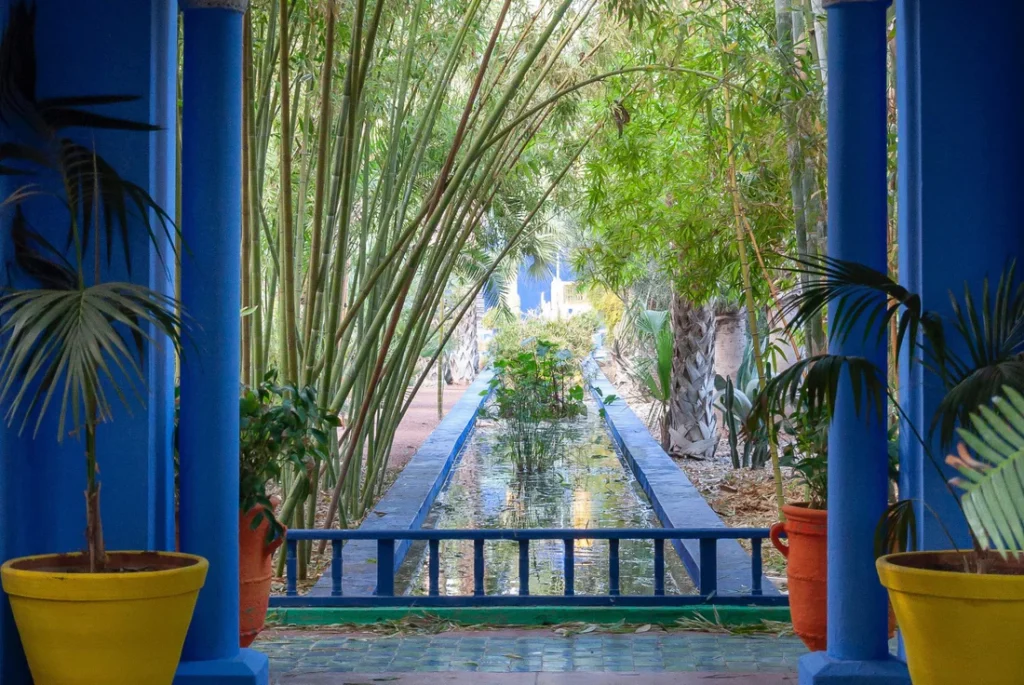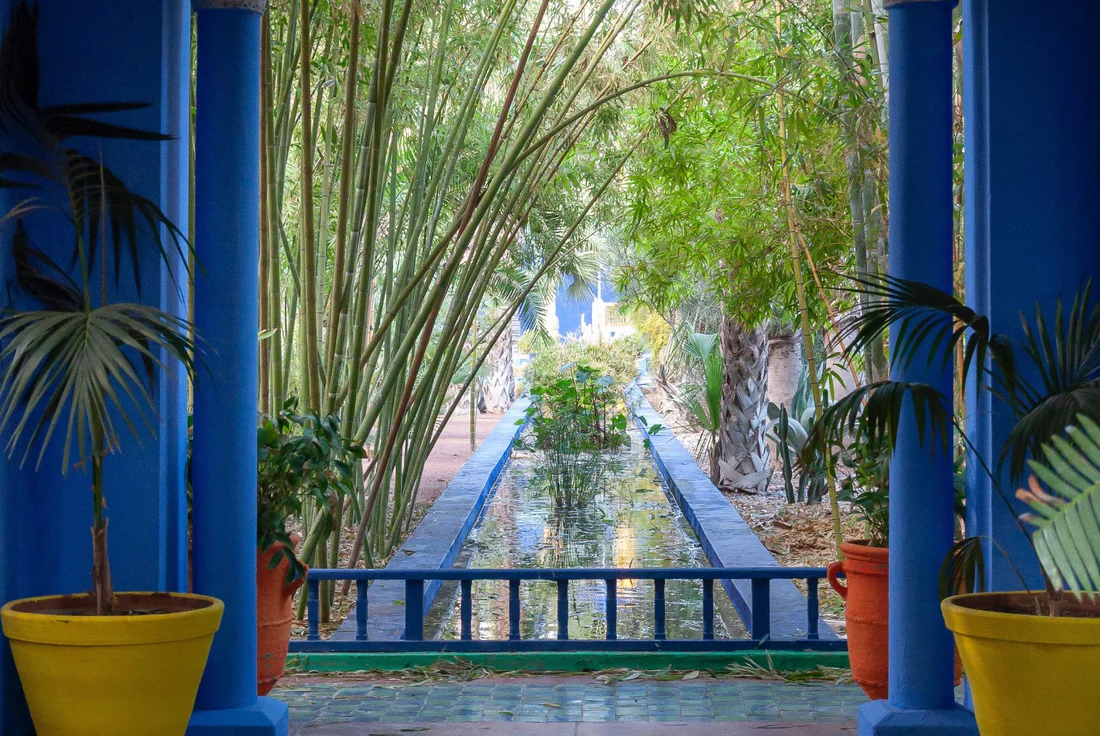
Designing a Moroccan-style courtyard garden offers a captivating blend of vibrant aesthetics, cultural heritage, and serene functionality. Rooted in the traditions of North Africa, these gardens are intimate oases that transform outdoor spaces into tranquil retreats. Characterized by intricate tilework, lush greenery, and water features, they reflect a harmonious balance between nature and architecture. Whether you have a sprawling backyard or a modest patio, this style adapts beautifully, inviting relaxation and sensory delight. In this article, we’ll explore the essential elements, step-by-step design process, and practical tips to create your own Moroccan-inspired haven. By the end, you’ll have a clear roadmap to craft a space that’s both timeless and personal.
Understanding the Essence of Moroccan Design
Moroccan courtyard gardens draw inspiration from centuries-old Islamic architecture and the region’s arid climate. Historically, these spaces served as private sanctuaries within homes, offering shade and respite from the sun. The design prioritizes symmetry, geometric patterns, and a rich color palette—think deep blues, fiery oranges, and earthy terracotta tones. Water is a central symbol of life, often incorporated through fountains or reflecting pools. Plants like citrus trees and fragrant herbs enhance the sensory experience, while ornate details, such as hand-painted tiles, elevate the aesthetic. This fusion of utility and beauty defines the Moroccan style.
Choosing the Right Space for Your Courtyard
Before sketching your design, assess your available space. Moroccan courtyards thrive in enclosed or semi-enclosed areas, such as patios, atriums, or walled gardens. The key is creating a sense of seclusion, even in an urban setting. Measure your dimensions carefully—whether it’s a 10×10-foot nook or a larger expanse, the layout should feel intimate. Consider sunlight exposure, as many Moroccan plants like lavender and jasmine flourish in full sun. Drainage is equally critical, especially if you plan to add a water feature. A flat or slightly sloped surface works best to avoid pooling. With the right foundation, your courtyard will seamlessly blend form and function.
Crafting a Symmetrical Layout
Symmetry is the backbone of Moroccan garden design. Start by envisioning your courtyard as a series of balanced quadrants, radiating from a central focal point—perhaps a fountain or a decorative urn. Pathways made of mosaic tiles or gravel can delineate these sections, guiding the eye and foot traffic. Arrange seating areas, planters, and water elements mirrored on either side to maintain harmony. This structured approach doesn’t stifle creativity; rather, it provides a canvas for layering textures and colors. If space is tight, scale down to a single axis of symmetry, ensuring every element feels intentional and cohesive.
Selecting Authentic Moroccan Materials
Materials define the authenticity of your courtyard. Moroccan gardens favor natural, durable options like terracotta pots, wrought iron furniture, and zellige tiles—handcrafted ceramics with intricate geometric patterns. For flooring, consider stone pavers or tiles in warm hues to mimic the sunbaked landscapes of Marrakech. Wooden pergolas or trellises, stained in dark tones, add vertical interest and shade. Sourcing these materials might require some research; specialty retailers or online marketplaces like Houzz offer authentic options. Invest in quality over quantity—each piece should feel like a work of art, enhancing the garden’s longevity and charm.
Incorporating Water Features
Water is the heartbeat of a Moroccan courtyard. A central fountain, even a small tabletop one, introduces soothing sounds and reflects the sky, amplifying the sense of peace. Traditional designs often feature shallow basins with trickling spouts, adorned with colorful tiles. If budget allows, a narrow rill—a slender water channel—can snake through the garden, connecting different zones. For maintenance, ensure proper plumbing and a pump system; resources like This Old House provide DIY guides for installation. Position your water feature as the centerpiece, letting it anchor the surrounding plants and decor with its gentle presence.
Choosing Plants for a Moroccan Vibe
Plant selection bridges the gap between aesthetics and climate adaptability. Moroccan gardens favor drought-tolerant species that thrive in Mediterranean-like conditions. Citrus trees—orange, lemon, or lime—bring height and fragrance, their glossy leaves contrasting with vibrant fruit. Low-growing plants like rosemary, thyme, and lavender add texture and scent, while climbing jasmine or bougainvillea drapes walls in vivid blooms. For authenticity, opt for potted plants rather than expansive beds, mimicking the container gardens of Morocco. Check your local nursery or consult The Royal Horticultural Society for care tips tailored to your region’s climate.
Adding Color Through Tiles and Textiles
Color breathes life into a Moroccan courtyard. Zellige tiles in bold patterns—starbursts, arabesques, or chevrons—can line pathways, benches, or fountain edges, creating a visual feast. Complement these with textiles: think cushioned seating in jewel tones like sapphire, emerald, or ruby. Outdoor rugs in similar hues tie the space together, softening hard surfaces. These elements should feel layered but not chaotic; stick to a cohesive palette inspired by Moroccan souks. For inspiration, platforms like Architectural Digest showcase how designers balance vibrancy with restraint, ensuring every hue enhances the overall mood.
Designing Functional Seating Areas
A Moroccan courtyard isn’t just for looking—it’s for living. Seating areas should invite lingering, whether for morning coffee or evening gatherings. Wrought iron chairs with plush cushions, low wooden benches, or even a built-in banquette along a wall work beautifully. Arrange them around a small table for practicality, perhaps one with a tiled top for added flair. Shade is essential; a pergola draped with fabric or climbing vines keeps the space cool. Position seating to face the water feature or a striking plant, making every view intentional. Comfort and style should coexist, turning your garden into a social hub.
Lighting for Ambiance and Drama
Lighting transforms a Moroccan courtyard after dusk, casting a magical glow. Lanterns—whether hanging, tabletop, or floor-standing—are quintessential, often crafted from pierced metal or stained glass to project intricate shadows. String lights woven through trellises add a modern touch without breaking tradition. Solar-powered options keep maintenance low and eco-friendly. Place lights strategically to highlight key features: a fountain, a tiled wall, or a citrus tree. For installation ideas, Better Homes & Gardens offers practical advice on outdoor lighting. The goal is a warm, inviting atmosphere that extends your garden’s allure into the night.
Comparison Table: Traditional vs. Modern Moroccan Courtyards
| Aspect | Traditional Moroccan Courtyard | Modern Moroccan Courtyard |
|---|---|---|
| Water Feature | Hand-carved stone fountain | Sleek, minimalist pump system |
| Materials | Zellige tiles, terracotta | Concrete with tile accents |
| Plants | Citrus, jasmine in clay pots | Succulents, vertical gardens |
| Seating | Low benches, cushions | Modular outdoor furniture |
| Lighting | Metal lanterns | LED strips, solar lanterns |
This table highlights how tradition adapts to contemporary needs, offering flexibility in your design approach.
Maintaining Your Moroccan Courtyard
A Moroccan garden’s beauty lies in its upkeep. Water features need regular cleaning to prevent algae; a small brush and mild soap suffice. Plants require pruning—citrus trees especially benefit from annual trimming to boost fruit yield. Tiles and textiles should be weatherproofed; sealants protect against fading or cracking. Check drainage after heavy rain to avoid waterlogging. Seasonal refreshes, like swapping cushions or adding new herbs, keep the space vibrant. For detailed care schedules, Gardening Know How provides expert guidance. With consistent effort, your courtyard will remain a stunning retreat year-round.
Budgeting for Your Project
Cost can vary widely depending on scope. A small courtyard with a DIY fountain, secondhand furniture, and basic plants might start at $500. Larger spaces with custom tiles, professional plumbing, and mature trees could exceed $5,000. Prioritize splurges—like a quality fountain or tiles—while saving on accessories like cushions from thrift stores. Plan your budget in phases: hardscaping first, then plants, and finally decor. Online tools from HGTV can help estimate expenses. Flexibility is key; a Moroccan courtyard’s charm doesn’t hinge on extravagance but on thoughtful curation.
Overcoming Common Design Challenges
Challenges like limited space, harsh climates, or poor soil can arise. For small areas, use vertical planters or wall-mounted tiles to maximize impact. In cold regions, opt for portable pots you can move indoors during winter, or choose hardy evergreens. Poor drainage? Raised beds or gravel layers solve the issue. Research your local conditions—resources like The Spruce offer tailored solutions. Adaptability ensures your vision thrives, no matter the constraints. Patience and experimentation will refine your courtyard into a personalized masterpiece.
High-Quality FAQs
What makes a garden distinctly Moroccan?
A Moroccan garden stands out with its symmetry, vibrant tiles, water features, and fragrant plants like citrus and jasmine, all woven into a secluded, oasis-like space.
Can I design a Moroccan courtyard on a budget?
Yes, focus on DIY elements like a simple fountain, thrifted textiles, and affordable potted plants. Prioritize a few authentic touches, like tiles, to capture the style.
How do I maintain a water feature?
Clean it monthly with a soft brush and mild soap, check the pump regularly, and ensure proper water circulation to prevent stagnation or algae growth.
What if my climate isn’t Mediterranean?
Choose plants suited to your region—succulents for arid zones or evergreens for colder areas—and use portable containers to adjust seasonally.
How long does it take to create this garden?
A basic setup can take a weekend, while a detailed design with custom features might span weeks or months, depending on scale and resources.
Conclusion: Crafting Your Moroccan Oasis
Designing a Moroccan-style courtyard garden is an art of blending tradition with personal flair. From the soothing trickle of a fountain to the vibrant splash of zellige tiles, every element invites you into a world of beauty and calm. Start with a clear layout, choose authentic materials, and layer in plants and decor that speak to your senses. Whether you’re working with a tight budget or a grand vision, the process rewards patience and creativity. This garden isn’t just a space—it’s an experience, a daily retreat that echoes the soul of Morocco. Begin today, and let your courtyard bloom into a timeless sanctuary.

